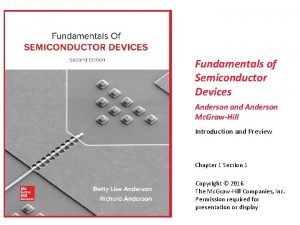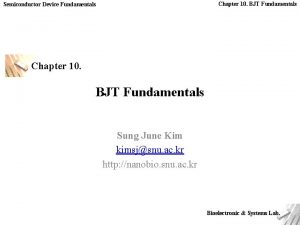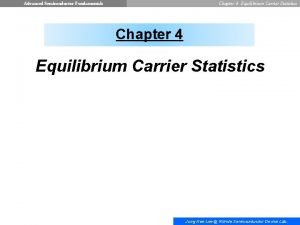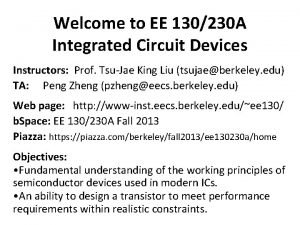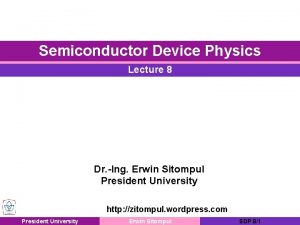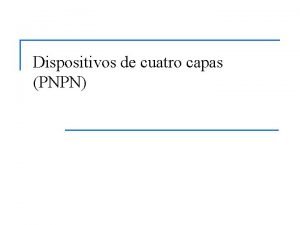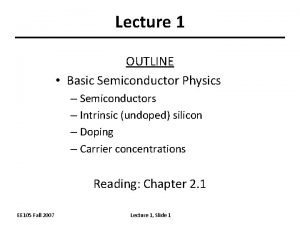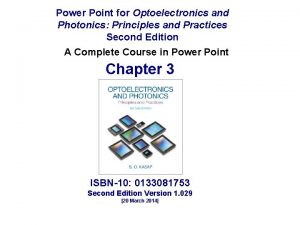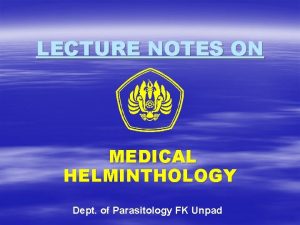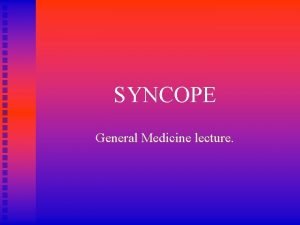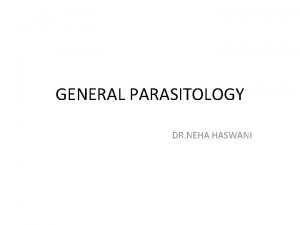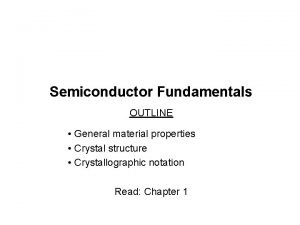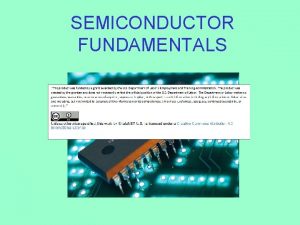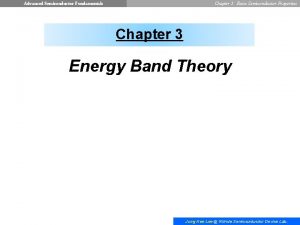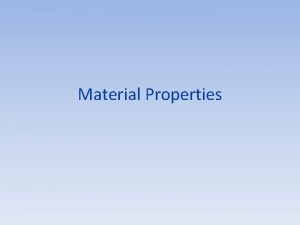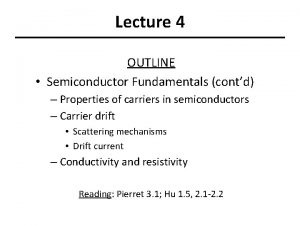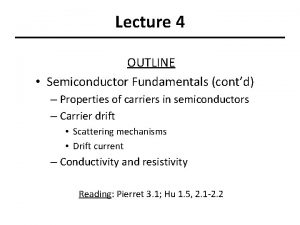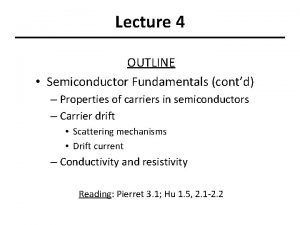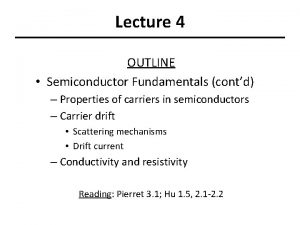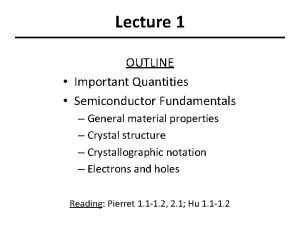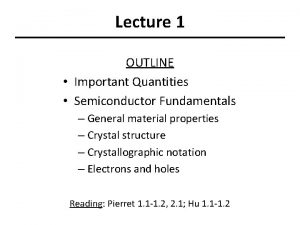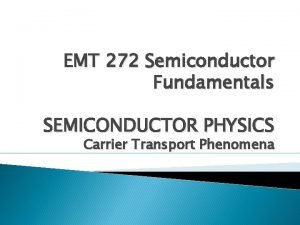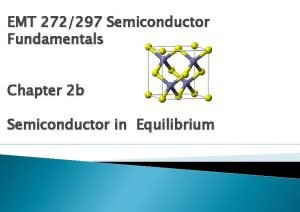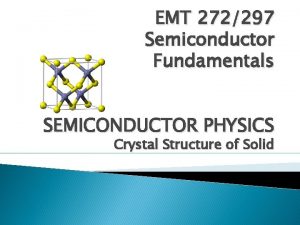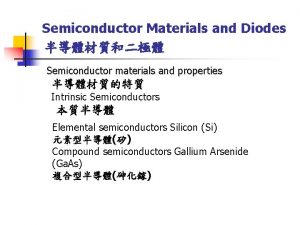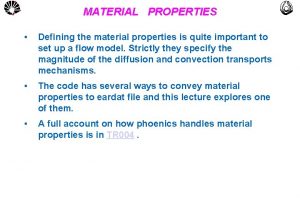Lecture 1 OUTLINE Semiconductor Fundamentals General material properties








![Crystallographic Notation Miller Indices: Notation (hkl) {hkl} [hkl] Interpretation crystal plane equivalent planes crystal Crystallographic Notation Miller Indices: Notation (hkl) {hkl} [hkl] Interpretation crystal plane equivalent planes crystal](https://slidetodoc.com/presentation_image_h2/7907468f628683bd05f9b85e350fe278/image-9.jpg)









- Slides: 18

Lecture 1 OUTLINE • Semiconductor Fundamentals – General material properties – Crystal structure – Crystallographic notation – Electrons and holes Reading: Pierret 1. 1 -1. 2, 2. 1; Hu 1. 1 -1. 2

What is a Semiconductor? • Low resistivity => “conductor” • High resistivity => “insulator” • Intermediate resistivity => “semiconductor” – conductivity lies between that of conductors and insulators – generally crystalline in structure for IC devices • In recent years, however, non-crystalline semiconductors have become commercially very important polycrystalline amorphous crystalline EE 130/230 M Spring 2013 Lecture 1, Slide 2

Semiconductor Materials Elemental: Compound: Alloy: EE 130/230 M Spring 2013 Lecture 1, Slide 3

From Hydrogen to Silicon EE 130/230 M Spring 2013 Lecture 1, Slide 4

The Silicon Atom • 14 electrons occupying the first 3 energy levels: – 1 s, 2 p orbitals filled by 10 electrons – 3 s, 3 p orbitals filled by 4 electrons To minimize the overall energy, the 3 s and 3 p orbitals hybridize to form 4 tetrahedral 3 sp orbitals Each has one electron and is capable of forming a bond with a neighboring atom EE 130/230 M Spring 2013 Lecture 1, Slide 5

The Si Crystal • Each Si atom has 4 nearest neighbors – “diamond cubic” lattice – lattice constant = 5. 431Å EE 130/230 M Spring 2013 Lecture 1, Slide 6

How Many Silicon Atoms per cm 3? • Total number of atoms within a unit cell: Number of atoms completely inside cell: Number of corner atoms (1/8 inside cell): Number of atoms on the faces (1/2 inside cell): • Cell volume: (0. 543 nm)3 • Density of silicon atoms: EE 130/230 M Spring 2013 Lecture 1, Slide 7

Compound Semiconductors • “zincblende” structure • III-V compound semiconductors: Ga. As, Ga. P, Ga. N, etc. ü important for optoelectronics and high-speed ICs EE 130/230 M Spring 2013 Lecture 1, Slide 8
![Crystallographic Notation Miller Indices Notation hkl hkl hkl Interpretation crystal plane equivalent planes crystal Crystallographic Notation Miller Indices: Notation (hkl) {hkl} [hkl] Interpretation crystal plane equivalent planes crystal](https://slidetodoc.com/presentation_image_h2/7907468f628683bd05f9b85e350fe278/image-9.jpg)
Crystallographic Notation Miller Indices: Notation (hkl) {hkl} [hkl] Interpretation crystal plane equivalent planes crystal direction <hkl> equivalent directions h: inverse x-intercept of plane k: inverse y-intercept of plane l: inverse z-intercept of plane (Intercept values are in multiples of the lattice constant; h, k and l are reduced to 3 integers having the same ratio. ) EE 130/230 M Spring 2013 Lecture 1, Slide 9

Crystallographic Planes and Si Wafers Silicon wafers are usually cut along a {100} plane with a flat or notch to orient the wafer during IC fabrication: EE 130/230 M Spring 2013 Lecture 1, Slide 10

Crystallographic Planes in Si Unit cell: View in <111> direction View in <100> direction EE 130/230 M Spring 2013 View in <110> direction Lecture 1, Slide 11

Electronic Properties of Si • Silicon is a semiconductor material. – Pure Si has relatively high electrical resistivity at room temp. • There are 2 types of mobile charge-carriers in Si: – Conduction electrons are negatively charged – Holes are positively charged • The concentration (#/cm 3) of conduction electrons & holes in a semiconductor can be changed: 1. by changing the temperature 2. by adding special impurity atoms ( dopants ) 3. by applying an electric field 4. by irradiation EE 130/230 M Spring 2013 Lecture 1, Slide 12

Electrons and Holes (Bond Model) 2 -D representation of Si lattice: When an electron breaks loose and becomes a conduction electron, a hole is also created. EE 130/230 M Spring 2013 Lecture 1, Slide 13 Si Si Si

What is a Hole? • Mobile positive charge associated with a half-filled covalent bond – Can be considered as positively charged mobile particle in the semiconductor • Fluid analogy: EE 130/230 M Spring 2013 Lecture 1, Slide 14

The Hole as a Positive Mobile Charge EE 130/230 M Spring 2013 Lecture 1, Slide 15

Intrinsic Carrier Concentration, ni conduction • At temperatures > 0 K, some electrons will be freed from covalent bonds, resulting in electron-hole pairs. For Si: ni 1010 cm-3 at room temperature EE 130/230 M Spring 2013 Lecture 1, Slide 16

Definition of Terms n ≡ number of electrons/cm 3 p ≡ number of holes/cm 3 ni ≡ intrinsic carrier concentration In a pure semiconductor, n = p = ni EE 130/230 M Spring 2013 Lecture 1, Slide 17

Summary • Crystalline Si: – – – 4 valence electrons per atom diamond lattice (each atom has 4 nearest neighbors) atomic density = 5 x 1022 atoms/cm 3 intrinsic carrier concentration ni = 1010 cm-3 Miller indices are used to designate planes and directions within a crystalline lattice • In a pure Si crystal, conduction electrons and holes are formed in pairs. – Holes can be considered as positively charged mobile particles. – Both holes and electrons can conduct current. EE 130/230 M Spring 2013 Lecture 1, Slide 18
 Fundamentals of semiconductor devices anderson solution
Fundamentals of semiconductor devices anderson solution Zerobioelectronic
Zerobioelectronic Advanced semiconductor fundamentals
Advanced semiconductor fundamentals Advanced semiconductor fundamentals
Advanced semiconductor fundamentals Ee 130
Ee 130 Semiconductor device fundamentals
Semiconductor device fundamentals Semiconductor device fundamentals
Semiconductor device fundamentals Semiconductor definition physics
Semiconductor definition physics Power semiconductor devices lecture notes
Power semiconductor devices lecture notes 01:640:244 lecture notes - lecture 15: plat, idah, farad
01:640:244 lecture notes - lecture 15: plat, idah, farad E vs k diagram
E vs k diagram Lecture outline example
Lecture outline example Lecture outline example
Lecture outline example Lecture outline example
Lecture outline example Lecture outline meaning
Lecture outline meaning Dyphilidium caninum
Dyphilidium caninum General medicine lecture
General medicine lecture General parasitology lecture notes
General parasitology lecture notes Example of sentence outline
Example of sentence outline
